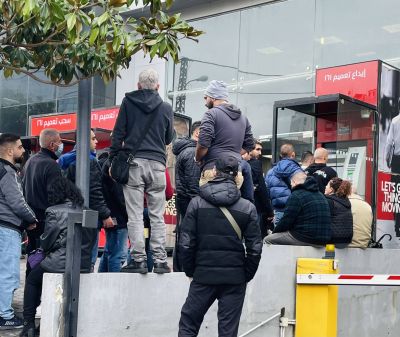
Depositors line up in front of distributors specializing in operations related to Circular No. 161. (Credit: Philippe Hage Boutros/L'Orient-Le Jour)
A year ago to the day, Banque Du Liban implemented a new mechanism that has adjusted and even reinforced the banking restrictions hindering Lebanese depositors’ free access to their bank accounts, despite such access being guaranteed by law as well as by the contracts binding them to their banking institutions.
Formalized by Circular No. 161, dated Dec. 16, 2021, this mechanism has since allowed holders of accounts in Lebanese lira, whose value has collapsed in the market, to convert and then withdraw small amounts in fresh dollars every month.
The term “fresh dollars” emerged during the crisis to refer to real dollars, which can be exchanged at the market rate, as opposed to those blocked in banks, known as “Lebanese dollars,” “lollars” or “bank dollars.”
The peculiarity is that the conversion and withdrawal operations via Circular No. 161 are not done at the market rate, but at BDL’s Sayrafa platform, whose stated objective was to unify the multiple exchange rates in force since the outbreak of the economic crisis and to make the foreign exchange market more transparent.
However, these objectives have still not been achieved, while the gulf between the Sayrafa rate and that of the parallel market continues to grow.
Evolving margin
When it was launched, Circular No. 161 was introduced as a way to compensate for the dwindling purchasing power of civil servants who are paid in lira and whose salaries were still calculated at the old official rate of LL1,507.5 against the dollar, which is no longer in use as the 2022 budget law entered into force on Nov. 15. However, this mechanism is also open to private salaries and even to companies.
At the time the circular was issued, Sayrafa’s posted rate was LL22,700 to the dollar, compared with a market rate of LL28,000. A year later, the gap is even more glaring: LL30,800 to the dollar on Sayrafa yesterday, while the market now peaks at over LL43,000.
Because of the difference between these two rates, the mechanism set up by Circular No. 161 acts, ultimately, as a means of subsidizing the purchase of dollars by companies and individuals.
Taking into account the above-mentioned figures, the text allows the holder of a bank account to obtain dollars at a rate lower than the market rate, with the possibility of making a capital gain through the exchange: a 100-dollar bill exchanged at LL43,000 is equal to LL4.3 million.
However, this amount, exchanged at the Sayrafa rate of LL30,800 against the dollar, represents almost $140, which implies an instantaneous gain of about 40 percent.
This is the first time that this margin has been so high in one year. It was about 23 percent on Dec. 16, 2021, the first theoretical day of application of the circular, and then just over 15 percent six months later, before rising again.
Combining circulars
The use of Circular No. 161 can be combined with the other measures circumventing banking restrictions. Among them is Circular No. 151, which allows the conversion and withdrawal of bank dollars into lira at a rate currently set at LL8,000 against the dollar. This is on top of Circular No. 158, which allows monthly withdrawals from accounts under restrictions of $400 in cash and the equivalent amount in lira at a rate of LL12,000 to the dollar, all under very specific conditions.
By combining the mechanism put in place by Circular No. 161 with the other two measures, Lebanese bank’s clients affected by the restrictions can marginally limit the losses they are forced to incur by being forced to withdraw their funds at below-market rates.
Concerning Circular No. 151, the equivalent of 100 bank dollars is LL800,000 or $18.6 at the rate of LL43,000 to the dollar.
If we apply the mechanism of Circular No. 161, and withdraw them at the Sayrafa rate, we would have a sum equivalent to $26.
With regard to Circular no. 158 and the equivalent of the $200 withdrawn in cash, this calculation applies: instead of their true value being equal to $55.8 (LL2.4 million converted at the market rate), they are now worth nearly $78.
However, this mechanism does not apply to the equivalent in lira of the $200 paid only by bank card.
According to a banking source, who requested anonymity as they are not authorized to speak to the press, the decision in the first instance rests with the BDL although the latter has never formally communicated on the subject.
Virtually limitless during the first months of application, the cash withdrawal limits via Circular No. 161 were then restricted to $500 per customer (per customer identification number in a bank), then $400 — sometimes less — for most banks.
From the counter to the ATM
In addition to the rate differential, the benefit (or loss reduction, depending on one's point of view) that a depositor can derive from Circular No. 161 also depends on the size of the limits allowed.
When it was launched, BDL gave banks the freedom to set limits on how much their customers could withdraw each month through the scheme.
In fact, there are two types of cash withdrawal limits: the limit on transactions that can be carried out by converting “bank dollars” into lira before converting them back into dollars, which are restricted by the conversion and withdrawal limits specific to each bank; and the limit on the amount of cash in lira that each customer can deposit directly with their bank to exchange for dollars at the Sayrafa rate (i.e., the $500 and $400 mentioned above).
But where do the dollars come from to feed this mechanism if the Lebanese banking sector does not have enough liquidity to allow depositors to recover their funds?
Circular No. 161 stipulates that the central bank sells to the banks and at the Sayrafa rate the dollars that can be used to honor the transactions carried out under this scheme.
The dollars in question are either drawn from reserves or directly on the market via means that have never been clearly explained.
Losses related to the difference in the exchange rate are therefore assumed by the BDL, as was the case for the subsidy mechanisms from which fuel importers benefited, for example.
Despite these grey areas, Circular no. 161 seems set to last, even though it was originally intended to be temporary.
Initially planned for two weeks, the text has indeed been extended 10 times since then (nine times for a period of one month and one for two months).
While it is currently applicable until the end of December 2022, there is no indication at the moment that it will not be extended again before the end of the month.
The operations were exclusively done at the counter at the beginning, a dedicated functionality has been integrated into the ATMs menus of, while some banks have recently decided to go as far as reserving some of them for this type of operation.
This article was originally published in French at L'Orient-Le Jour. Translation by Joelle El Khoury.


